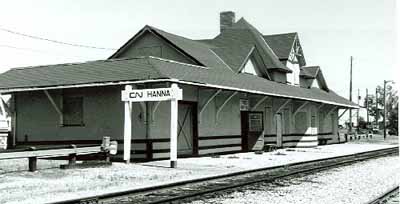Former Canadian Northern Railway Station
Heritage Railway Station of Canada
Hanna, Alberta

General view of the place
(© Great Plains Research Consultants, B. Potyondi, 1991.)
Address :
Railway Avenue (between Centre St. and 1 St. W), Hanna, Alberta
Recognition Statute:
Heritage Railway Stations Protection Act (R.S.C., 1985, c. 52 (4th Supp.))
Designation Date:
1991-11-22
Dates:
-
1913 to 1913
(Construction)
Event, Person, Organization:
-
Canadian Northern Railway
(Organization)
-
R.B. Pratt
(Architect)
Other Name(s):
-
Canadian National Railway Station
(Other Name)
Research Report Number:
RS-067
Description of Historic Place
The former Canadian Northern Railway (CNoR) station at Hanna, Alberta, was constructed in 1913. It is a large 1 ½ storey standard plan divisional station located on Railway Avenue. It can be readily identified by the steeply pitched, layered roofline it shares with many other stations constructed by the CNoR and later occupied by Canadian National Railways.
Heritage Value
The station at Hanna has been designated a heritage railway station because of its historical, architectural and environmental significance.
The former Canadian Northern Railway (CNoR) station at Hanna, Alberta, was constructed in 1913 on the CNoR Goose Lake Line from Saskatoon to Calgary. The station is directly associated with the establishment and evolution of Hanna as a community which sprang up overnight as a divisional point for the railway and became a regional distribution centre. The station itself is a particularly good example of a standard plan used by the company at divisional points and larger centres throughout western Canada, one created by contract architect R.B.Pratt. Over time, Hanna grew as a regional marketing and industrial centre as grain elevators along the track near the station continue to attest. While steam locomotives still dominated the rails, Hanna was second only to Edmonton among Alberta CNR repair depots. Eventually operated by Canadian National Railways (CNR), the station continued to serve as a divisional point and to provide both passenger and freight service until August 1990.
The heritage value of the Hanna station is defined by its exterior materials, form, and detailing, and by its trackside setting. (An extension at the west end, added in 1952, does not contribute to the station’s value.)
Source:
· Heritage Character Statement, Hanna Canadian Northern Railway Station, January 1992. Heritage Assessment Report RSR-67, date 1991.
Character-Defining Elements
Character-defining elements of the Former CNoR Station at Hanna include: the station’s irregular rectangular footprint, its 1½ storey massing under a modified hipped roof with a raised central pyramid and substantial end and side gables, its complex profile and prominent, intricate roof definition from all four perspectives (central pyramid, gables with prominent trusses on all sides), its substantial proportions, the balance inherent in its vertical definition, the rhythmic original placement of its apertures and brackets, the smooth aesthetic integration of special railway features such as a projecting telegrapher’s bay and broad eaves to provide passenger shelter, the picturesque inspiration of its surviving details: irregular roof forms, multi-paned windows, prominent brackets, broad eaves, gable forms, decorative gable trusses, the varying textures of its original materials: wood siding, shingle facing and roof, wood doors and trim, the presence of modifications subsequently made to station materials as a form of fireproofing: stucco walls, the station’s platform frame construction technology, any original fabric surviving inside the station, legibility of any and all indications of the station’s original layout and plan including the nature and function of its interior spaces.